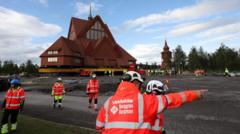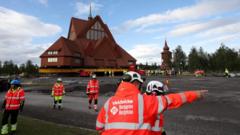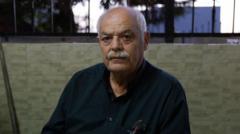In a stunning engineering feat, the Kiruna Church is being moved to ensure the preservation of its historical significance and community connection.
**Kiruna's Historic Church Embarks on Two-Day Relocation Journey**

**Kiruna's Historic Church Embarks on Two-Day Relocation Journey**
A 113-year-old timber church is relocated brick by brick to save it from subsidence caused by mining activity.
A monumental endeavor is unfolding in Kiruna, Sweden, where the region's iconic timber church, dating back to 1912, is being relocated a distance of 5 kilometers (about 3 miles) to avoid the risks posed by ground subsidence due to extensive iron ore mining. This extraordinary move, involving the lifting of the structure onto massive rolling platforms, commenced on Tuesday and is anticipated to stretch over a two-day journey at a maximum speed of 500 meters per hour.
Kiruna, located 145 kilometers north of the Arctic Circle, has been forced to relocate several of its buildings owing to increasing ground fissures that threaten infrastructure. "This is a historic event, a very big and complex operation, and we don’t have a margin for error," said project manager Stefan Holmblad Johansson, whose composed demeanor reflects years of meticulous planning. Local culture strategist Sofia Lagerlöf Määttä encapsulated the collective sentiment: "It’s finally happening; we've been waiting for years."
The Kiruna Church stands 35 meters (115 feet) high and weighs a staggering 672 tons. Swedish law prevents mining activities directly beneath buildings, safeguarding residents from dangers of structural failure over time. As the efforts roll forward, the operator of the iron ore mine, LKAB, is financing the city’s relocation expenses, which total over 10 billion Swedish krona ($1 billion; £737 million).
Renowned for its beauty, the church has served as a central hub for spiritual gatherings, and with its relocation, residents are not just moving a building but also bringing their shared histories along. Project manager Johansson noted the complexity of maneuvering such an expansive structure intact. "The biggest challenge was preparing the road for a building this wide. We've widened the road to 24 meters (79 feet) and removed obstacles like lampposts and traffic lights along its path," he explained.
A critical aspect of the move is safeguarding the church's interiors, particularly its significant altar painting, which is affixed securely, making removal nearly impossible without risking damage. Instead, the beloved artwork and the church's massive organ, containing 1,000 pipes, will be left intact and stabilized within the structure.
"To the community, this is an emotional moment," expressed Vicar Lena Tjärnberg. The congregation acknowledges the necessity of the move as they transition from their historical roots to a new center. Thousands of onlookers, including high-profile visitors like Sweden's King Carl Gustaf, are expected to witness this significant relocation, broadcast live by Swedish television as part of "slow TV" programming—a rare occasion to see history in motion.




















